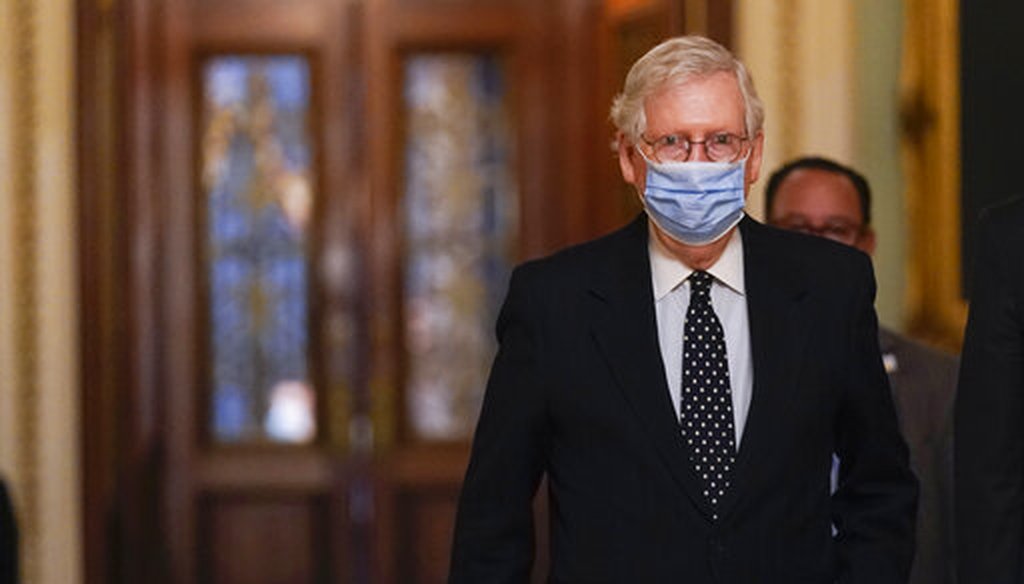Get PolitiFact in your inbox.

Senate Majority Leader Mitch McConnell, R-Ky., walks from the Senate floor to his office on Capitol Hill on Jan. 6, 2021. (AP)
Mitch McConnell says, accurately, that Joe Biden’s win wasn’t unusually close
If Your Time is short
• By most metrics — including electoral votes, the popular vote margin, the percentage of the vote he won, and the margins in the seven closest states — Biden did put up impressive numbers compared with recent presidential winners.
In a speech before what he called "the most important vote I've ever cast," Senate Majority Leader Mitch McConnell, R-Ky., rejected challenges to the validity of Joe Biden’s victory in the 2020 presidential race.
"The Constitution gives us here in Congress a limited role," McConnell said on Jan. 6, shortly before the Capitol was breached by mobs of President Donald Trump supporters. "We cannot simply declare ourselves a national board of elections on steroids. The voters, the courts, and the states have all spoken. They've all spoken. If we overrule them, it would damage our republic forever."
McConnell went on to say that "this election actually was not unusually close. Just in recent history, 1976, 2000, and 2004 were all closer than this one. The Electoral College margin is almost identical to what it was in 2016. If this election were overturned by mere allegations from the losing side, our democracy would enter a death spiral."
Was McConnell correct that the 2020 election "was not unusually close"? The final data provides strong support for McConnell’s assertion.
Here’s a rundown of the evidence.
The Electoral College
Biden’s Electoral College victory was exactly the same as Trump’s in 2016: Both won states with a collective 306 electoral votes.
Four years ago, Trump declared this number of electoral votes to be "a massive landslide." We rated that False, noting that 306 electoral votes ranks no better than the bottom quarter of Electoral College showings in American history, and no better than the bottom one-third of the showings since the end of World War II.
Experts say the more restrained characterization by former President Barack Obama — that Biden’s victory was "decisive" — is well-supported.
Biden’s electoral vote total, like Trump’s, "was on the low side," said John J. Pitney Jr., a Claremont McKenna College political scientist. "The big difference, of course, is that Trump lost the popular vote. Biden is winning a majority of the popular vote, and by a healthy margin."
Biden’s 306 electoral votes rank higher than either victory by George W. Bush, who accumulated only 271 in 2000 and 286 in 2004. It would also be slightly larger than the number won by Jimmy Carter in 1976, Richard Nixon in 1968, and John F. Kennedy in 1960.
Biden’s achievement is especially notable since it occurred during a period known for high partisan polarization.
"The era of landslide elections appears to be behind us," said Barry Burden, a University of Wisconsin-Madison political scientist. "The strengthening of partisanship in the electorate has dampened the magnitude of swings from one party to the other."
The popular vote margin
An even stronger sign of the decisiveness of Biden’s victory was the popular vote. The popular vote doesn’t determine the presidential victor — otherwise we would have had President Al Gore and President Hillary Clinton — but comparing the margin of Biden’s popular-vote victory with that of his predecessors suggests how broad-based his support was this year.
When all ballots were counted, Biden led the popular vote tally by almost 7.06 million votes, according to the Cook Political Report's 2020 National Popular Vote Tracker.
This means Biden amassed a wider popular vote margin than any candidate since 1996 except for Obama in 2008, who won by more than 9.5 million votes.
Biden’s popular-vote win was wider than the reelection victories of George W. Bush and Obama. It’s also wider than the popular-vote victories of Al Gore in 2000 and Hillary Clinton in 2016, both of whom lost the electoral vote. And it's wider than Bill Clinton amassed in his first victory in 1992.
Meanwhile, it was far wider than John F. Kennedy in 1960, Richard Nixon in 1968, and Jimmy Carter in 1976, and it was only about 18,000 votes shy of George H.W. Bush’s winning margin in 1988, when Bush won a whopping 426 electoral votes.
Percentage of the popular vote
Arguably an even more impressive measure of Biden’s win is his percentage of the popular vote. Biden, running as the candidate of the out-of-power party, secured 51.3% of the popular vote.
Going back to 1932, Biden’s percentage of the vote for the out-of-power party was exceeded only by the 55% won by Dwight Eisenhower, the Republican running to succeed Democrat Harry Truman in 1952, and the nearly 53% by Obama, who was running to succeed Republican George W. Bush in 2008.
In fact, you have to go back to 1932, when Franklin D. Roosevelt ousted President Herbert Hoover amid the Great Depression, to find a higher percentage of the vote for a candidate taking on an incumbent.
The closest states
We looked at the collective margins for the seven closest states in the four close elections in recent history: 2000, 2004, 2016 and 2020.
Collectively, the margins for these seven states in 2020 were 284,597 — wider than any of the other three elections.
The seven closest states we looked at for 2020 were, in descending order, Arizona, Georgia, Wisconsin, Nevada, New Hampshire, Maine, and North Carolina. (We excluded non-competitive states such as Delaware and Wyoming.) In the end, the highly competitive states of Pennsylvania and Michigan didn’t even make the list of seven closest states.
The 2000 election remains the benchmark for a close election. The seven closest states that year — Florida, New Mexico, Wisconsin, Iowa, Oregon, New Hampshire and Nevada — collectively had just a 46,000-vote margin.
By contrast, the seven closest states in 2020 currently have a collective margin more than six times wider than the closest seven in 2000.
Where Biden’s victory was weaker
The one metric that shows a relatively close race is the number of added votes in various states that could have tipped Trump into victory in those states and, in turn, could have gotten him to 270 electoral votes.
Trump could have won the Electoral College, narrowly, if he’d secured an additional 10,457 votes in Arizona (with 11 electoral votes), another 11,779 votes in Georgia (16 electoral votes), 20,682 more votes in Wisconsin (10 electoral votes), and 22,641 added votes in Nebraska’s 2nd congressional district (which allocates one electoral vote on its own).
Together, that’s fewer than 66,000 votes that, if perfectly allocated among those states, would have flipped the election to Trump. This amounts to .04% of all votes cast.
Our ruling
McConnell said, "This election actually was not unusually close."
By most metrics — including electoral votes, the popular vote margin, the percentage of the vote he won, and the margins in the seven closest states — Biden did put up impressive numbers compared with recent presidential winners.
The sole notable sign of a close race was that, due to the vagaries of the electoral college, only about 66,000 more votes for Trump — if they were perfectly allocated among the right states — would have flipped the election from Biden to Trump. But that dynamic has been the case in other recent presidential elections.
We rate the statement True.
Our Sources
Newsweek, "Full Text of Mitch McConnell's Speech Before 'Most Important' Vote of His Career," Jan. 6, 2021
PolitiFact, "How narrow was Joe Biden’s victory over Donald Trump?" Nov. 13, 2020
Decision Desk HQ, election results, 2020
Dave Leip's Atlas of U.S. Elections, election results, through 2016
Cook Political Report, 2020 National Popular Vote Tracker
Sabato's Crystal Ball, "Notes on the State of the 2020 Election," Nov. 12, 2020
Barack Obama, tweet, Nov. 7, 2020
PolitiFact, "Donald Trump's Electoral College victory was not a 'massive landslide," Dec. 12, 2020
Email interview with Alan Abramowitz, Emory University political scientist, Nov. 12, 2020
Email interview with John J. Pitney, Jr., Claremont McKenna College political scientist, Nov. 12, 2020
Email interview with Barry Burden, University of Wisconsin-Madison political scientist, Nov. 12, 2020
Browse the Truth-O-Meter
More by Louis Jacobson
Mitch McConnell says, accurately, that Joe Biden’s win wasn’t unusually close
Support independent fact-checking.
Become a member!
In a world of wild talk and fake news, help us stand up for the facts.










































